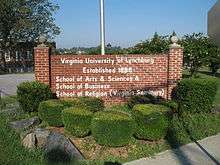Virginia University of Lynchburg
 | |
Former names |
Virginia Seminary Virginia Theological Seminary and College Virginia Seminary and College |
|---|---|
| Motto | Sibi Auxilium et Libertas |
| Type | Private, HBCU |
| Established | 1886 |
| President | Kathy Franklin (Interim) |
Administrative staff | 32 |
| Students | 205 |
| Undergraduates | 85 |
| Location |
Lynchburg, Virginia, U.S. 37°23′42.7″N 79°9′6.3″W / 37.395194°N 79.151750°WCoordinates: 37°23′42.7″N 79°9′6.3″W / 37.395194°N 79.151750°W |
| Campus | Suburban |
| Athletics | Independent |
| Nickname | Dragons |
| Website | |
|
Virginia University of Lynchburg | |
  | |
| Location | 2058 Garfield Ave., Lynchburg, Virginia |
| Area | 6.82 acres (2.76 ha) |
| Built | 1888 |
| Architect | Archer, Romulus C., Jr. |
| Architectural style | Colonial Revival, Beaux-Arts |
| NRHP Reference # | 11000035[1] |
| VLR # | 118-5297 |
| Significant dates | |
| Added to NRHP | February 22, 2011 |
| Designated VLR | December 16, 2010[2] |
Virginia University of Lynchburg is a private, historically black university located in Lynchburg, Virginia. The university currently offers instruction and degrees, primarily in religious studies, including a Doctorate of Ministry program.
History

Virginia University of Lynchburg is the oldest school of higher learning in Lynchburg. The school was founded in 1886 and incorporated in 1888 by the Virginia Baptist State Convention as the coeducational "Lynchburg Baptist Seminary". Classes were first held in 1890 under the name Virginia Seminary.[3] With the offering of a collegiate program in 1900, the name was again changed, to Virginia Theological Seminary and College. In 1962, the institution was renamed to the Virginia Seminary and College. Finally, in 1996, the school was given its current name. The campus includes three historic academic buildings on 6.82 acres: Graham Hall (1917), Humbles Hall (1920–21) and the Mary Jane Cachelin Memorial Science and Library Building (1946). These buildings and the Hayes Monument (c. 1906) comprise a historic district,[4] which was listed on the National Register of Historic Places in 2010.[1]
Its first President was the Rev. Phillip F. Morris, pastor of the city's Court Street Baptist Church. Seeking a financial patron, Morris agreed to step down as president rather than yield to the demand of the American Baptist Home Mission Society that he step down from the pulpit to assume full-time leadership of the school. Rev. Morris would later serve as President of the National Baptist Convention. Rev. Gregory W. Hayes, a graduate of Oberlin College, assumed the full-time position as President in 1891, serving until his death in 1906. His wife, Mary Rice Hayes Allen, mulatto daughter of a Confederate general and mother of author Carrie Allen McCray, assumed the presidency until replaced by Dr. JRL Diggs in 1908.
During Hayes' administration, controversy arose between black separatists and accommodationists over the future of the school. The chief patron wished it to become a pre-collegiate manual training institution. Hayes, among the separatists, returned the patronage to retain and strengthen black autonomy and academic integrity. This move eventually led to a schism within the National Baptist Convention.
In July 2010, the school reached an agreement with Liberty University to help VUL students looking for degrees not offered at the school to complete their degrees at Liberty.[5]
Among the alumni of the university is John Chilembwe, a Nyasa (Malawian) Baptist preacher and leader of the 1915 Chilembwe uprising, who graduated in 1901.
Athletics
Virginia University of Lynchburg teams participate as a member of the United States Collegiate Athletic Association. They are athletically known as the Dragons. Men's sports include baseball, basketball, football, golf, indoor and outdoor track and field; while women's sports include basketball, indoor and outdoor track and field, softball and volleyball.
References
- 1 2 "National Register of Historic Places Listings". Weekly List of Actions Taken on Properties: 2/22/11 through 2/25/11. National Park Service. 2011-03-04.
- ↑ "Virginia Landmarks Register". Virginia Department of Historic Resources. Retrieved 19 March 2013.
- ↑ Bogger, Tommy L. "John M. Armistead (1852–1929)". Encyclopedia Virginia. Retrieved 26 August 2015.
- ↑ Ashley Neville & John Salmon (September 2010). "National Register of Historic Places Inventory/Nomination: Virginia University of Lynchburg" (PDF). Virginia Department of Historic Resources. and Accompanying six photo
- ↑ "Virginia University of Lynchburg, Liberty University strike deal for degrees". Retrieved 2010-07-10.

